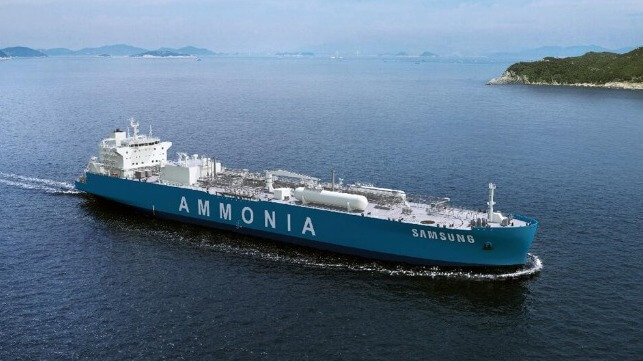Innovative Ship Designs Using Ammonia Receive AiPs at Posidonia

A lineup of designs is being highlighted during the week-long Posidonia trade show in Greece this week. Predictability much of the attention and excitement is coming for the designs advancing alternative power and specifically approaches to ammonia and hydrogen. With much of the discussion on decarbonization and the challenges for the industry, shipbuilders and technology companies are highlighting applications and approaches to produce a new generation of ships.
South Korea's Samsung Heavy Industries drew attention for its design of an ammonia fuel cell-powered very large ammonia carrier (VLAC). Using technology from US-based Amogy, the vessel would crack ammonia into hydrogen and nitrogen used to create electric power from the chemical reaction of hydrogen and oxygen.
Samsung presented several different iterations of its vessel concept. DNV and the American Bureau of Shipping (ABS) awarded AiPs for a 96,000 cbm VLAC. Korean Register (KR) awarded it for a 150,000 cbm design.
HD Hyundai Heavy Industries and Capital Gas also presented concepts for a very large ammonia carrier design capable of 93,000 cbm. They also are incorporating technology for the startup Amogy that splits ammonia. They said Amogy’s technology would provide approximately 1400 kW of auxiliary power equivalent to a diesel generator. ABS and the Liberian Registry reviewed the feasibility of the design and awarded the AiP based on current regulatory guidelines.
Working with Hyundai Glovis and G-Marine Service, HD Hyundai Heavy Industries also presented a different concept applied to a next-generation ammonia-fueled pure car and truck carrier. Hyundai highlighted a self-developed membrane-type, AICON fuel containment system, specifically designed to handle the toxicity and corrosiveness of the ammonia fuel system. KR verified the system based on classification rules and domestic and international regulations.
Guangzhou Shipyard International (GSI) also signed a joint development project with Lloyd’s Register for the design of what they are calling the world’s largest VLAC. Their target is a carrying capacity of 100,000 cbm.
Looking to the emerging business opportunities, Capital Gas also highlighted the transportation of liquified CO2 which would be shipped under pressure. While the company is already building four midsize carriers, they are also working with Hyundai to double the vessel’s capacity to reach a 40,000 cbm LCO2 carrier. Lloyd’s Register is also working on the project and provided the AiP.
That is a sampling of the projects being presented and highlighting their advancement to AiP approval.
